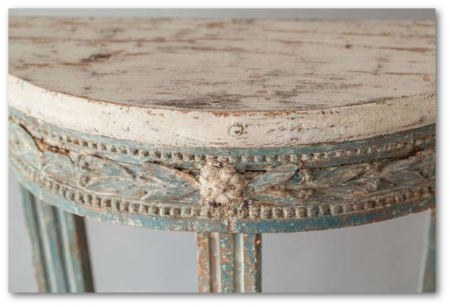Gustavian Style
Gustavian Style began with King Gustave III. He only reigned for 20 years (1772 – 1792) yet his patronage of the arts started a major design style.
After visiting the French courts of Versailles in 1771 he returned home as King, staged a quick coup d’état and quickly developed a style that was heavily influenced by the French. Instead of focusing on Rococo Sweden developed a style concentrating on symmetry, straight lines, columns and Greco-Roman motifs which sets it apart from the French.
While early Gustavian is a restrained interpretation of the French Louis XV and Louis XVI style, the Late Gustavian style is closely identified with Italy after engravings inspired by the excavations at Pompeii and Herculaneum began to circulate in Sweden.

The more ornate furnishings were reserved for royal palaces and the upper class. Downstairs the receiving rooms were filled with rosewood and gilding while upstairs even the kings bedroom was painted. The style is distinctive in its clean, hand-carved lines and cool color palette of blues, grays, and weathered whites.

The style quickly gained popularity with the average citizen. The average manor house in Sweden could not afford the gilded estate furniture found at the royal houses. Therefore, local craftsman recreated these designs from materials and methods more readily available to them. Techniques such as faux marbled surfaces, using Swedish “massive pine” instead of mahogany, and painted murals on the walls in place of wallpaper, were used to achieve the same stylistic effects. The light painted finishes provided a reflective quality that was desired during the long dark winters.

Gustave was an enlightened leader and in fact was the first neutral head of state in the world to recognize the United States. He was a strong patron of the arts and took Sweden to a level of architectural and cultural sophistication never known before. He transformed this once remote European country into the “Paris of the North,” setting a standard of style for Swedish society that continued well into the 19th century.
His most notable building projects include the Royal Opera in Stockholm and the Haga Echo Temple.

In 1792 Gustave III attended a masquerade ball at the Royal Opera house. He was shot in the back by a malcontented nobleman, at his Opera house. The assassination inspired Verdi’s 1859 opera The Masked Ball.

The popularity of Gustavian style has continued to grow over the years inspiring designers to this day. The style we are familiar with tends towards the distressed grey, soft blues and off-white. It still maintains a distinct look that is less ornate than other parts of the world.


Love receiving these little history lessons! It’s great to see the styles and where they originated from keep it up!!
Thank you Jenny. They are fun to write.